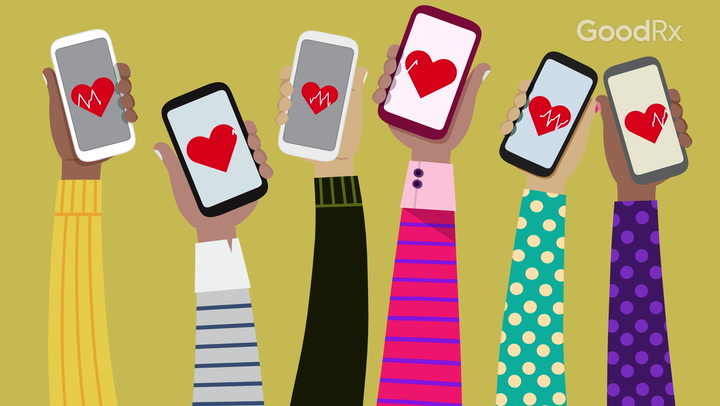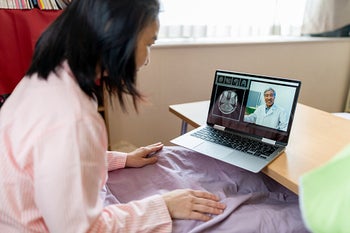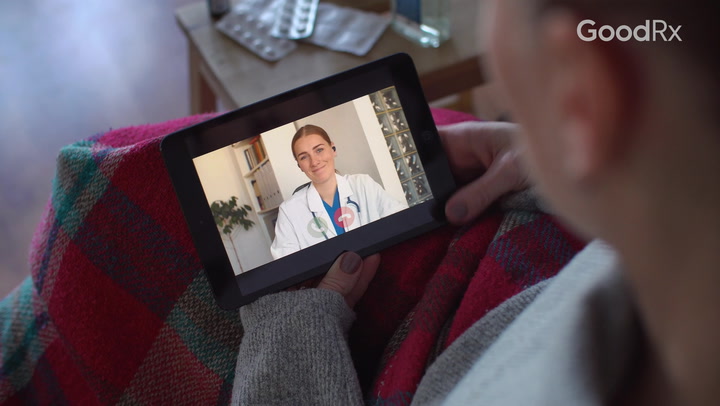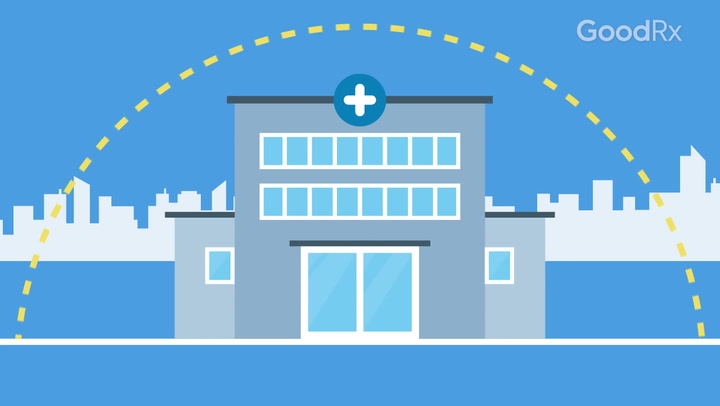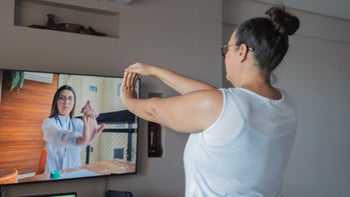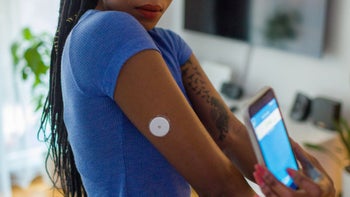
Overview
Telehealth is a broad term that describes health-related digital technologies. These technologies include fitness apps, online patient portals, and video platforms for chats between patients and providers, to name a few.
The Health Resources & Services Administration defines telehealth as “the use of electronic information and telecommunication technologies to support long-distance clinical health care, patient and professional health-related education, public health, and health administration. Technologies include video conferencing, the internet, store-and-forward imaging, streaming media, and terrestrial and wireless communications.”
Telehealth has been around for decades. Perhaps its earliest use dates back to the 1950s. The Nebraska Psychiatric Institute and Norfolk State Hospital created a closed-circuit television (CCTV) link for psychiatric evaluations.
Since then, telehealth has gotten more sophisticated. And it exploded by leaps and bounds during the COVID-19 pandemic.
Telemedicine vs. telehealth
As mentioned above, telehealth is a broad term covering a wide range of digital technologies. Telemedicine sits under the telehealth umbrella and is specific to provider/patient care. The American Medical Association defines telemedicine as:
Real-time, audio-video communication tools that connect physicians and patients in different locations
Store-and-forward technologies that collect images and data such as lab reports or prerecorded videos to be transmitted or interpreted later
Remote patient-monitoring tools, such as blood pressure monitors, Bluetooth-enabled digital scales, and other wearable devices that can communicate biometric data for review
How it works
Typically there are two ways to access a provider using telehealth. First, you can schedule a virtual visit with your provider or a specialist if their practice offers telemedicine. Secondly, you can use an app like GoodRx Care.
Whether you schedule an appointment with your doctor or through an app, you’ll want to follow these steps for a successful visit:
Test your device’s webcam and microphone before the appointment.
Sign in 15 minutes before your appointment.
Fill out paperwork and answer questions in advance as needed.
Make sure you understand the payment or reimbursement process.
Services
Telehealth services range from patient education webinars to treatment of injuries often seen in urgent care clinics. Here’s a list of some common services:
Condition management and education: Telemedicine video visits work well for patients who manage chronic conditions such as diabetes. They’re also great for educational sessions for issues like prenatal care or inflammatory bowel disease.
Medication management and refills: Your provider may need to check in with you regularly to assess your medications. During a remote telemedicine appointment, you can share how you’re doing and they can adjust your prescriptions.
Mental health counseling: Why drive to meet with a therapist when you can do so from the comfort of your own couch? Meeting with a therapist, social worker, or psychologist has never been easier.
Primary care or urgent care: Whether it’s a first visit or a follow-up, healthcare providers treat a long list of ailments via telemedicine.
Examples of Telehealth Services
Cost
Fees for telemedicine visits vary depending on the service, the provider, and whether your insurance covers the visit.
That said, here are some examples of out-of-pocket costs for common conditions:
Acne: anywhere from $43 to $86
Birth control: likely less than $50
Cold sore: less than $20 to about $60
Erectile dysfunction: about $30 to $70
Your insurance plan may save you money by covering telehealth services. Coverage depends on the state you live in, your policy, and whether the telehealth provider accepts insurance (including Medicare). Your best bet is to talk to a representative with your insurance plan before scheduling a virtual visit.
But you don’t need insurance to use these services. In fact, many telemedicine providers accept cash. But it still helps to compare prices and read between the lines to make sure you understand what you’re signing up for.
Online prescriptions
Many people wonder if they can get a prescription through a telemedicine visit. The answer is “yes,” in some cases.
It all depends on your state’s online prescription laws. Typically, online doctors can prescribe common medications like antibiotics, birth control, thyroid, blood pressure, and many other medications. But there are special rules for controlled substances like Xanax, Adderall, and Vicodin. And in some cases, you may need to see an in-person provider first.
Whether you need a prescription refill or you’re wondering about a new prescription, make sure to ask questions before you schedule a virtual appointment. The clinic or healthcare provider can give you information about their prescription policies. That way, you can decide whether or not telemedicine is right for you.
Common concerns
Yes. Your privacy is protected if the provider is compliant with HIPAA (Health Insurance Portability and Accountability Act) and has appropriate security measures. HIPAA-compliant platforms that have extra security measures include Skype for Business, Zoom for Healthcare, and Google G Suite Hangouts Meet. Apps like GoodRx Care and MDLive also protect health information under HIPAA.
But when the COVID pandemic made in-person visits nearly impossible, the government’s Office for Civil Rights (OCR) relaxed its rules for telehealth practices. The OCR told providers they could conduct virtual visits on non-HIPAA-compliant platforms such as Skype and FaceTime — platforms prone to hackers. And keep in mind: These policies (and others) may change in 2023 and 2024, as the COVID public health emergency has now come to an end.
To protect yourself and your health information, ask your provider if their technology uses multi-factor authentication (MFA). It requires two or more ways to prove your identity, like a password plus a PIN. Telehealth practices with MFA tend to be more secure.
To use telehealth, you should be aware of some technical requirements. For example, you will most likely need to have a working computer or a mobile phone that has a video camera or texting ability. You will also need to have a connection to the internet. If you've used video chat or text before, telehealth will be very similar.
Remember that you can always call the provider for help. Note that you may need to fill out forms and upload a photo and a copy of your ID before your visit.
Maybe. Some providers or insurance companies require an in-person visit first to establish a relationship with the provider, but many don’t. Ask before you fill out any forms.
Some states require a face-to-face interaction on video for a telehealth appointment. Other states allow communication through messaging or video.
Apps like GoodRx Care are designed to work without an initial in-person consultation.
It depends on why you’re seeing the online doctor. Telemedicine can be effective when the service you need mainly requires talking and listening because that can be easily accomplished on a video chat. For example, a study shows that “telemedicine is instrumental in improving diabetes patient care, as well as providing significant cost benefits.”
Telehealth can also be effective for diagnosing and treating a range of health conditions. Another study shows that telemedicine visits for nausea, stomach pains, and minor injuries offered the same level of care as in-person appointments.
But sometimes telemedicine just isn’t appropriate. Some studies show how providers can’t properly diagnose illnesses like sore throats and respiratory infections during web visits. Some treatments need urgent lab tests or hands-on procedures, which can’t be done virtually. And if you experience a medical emergency, a telemedicine visit may delay lab testing or lifesaving treatment.
References
Akhtar, M., et al. (2018). Telemedicine physical examination utilizing a consumer device demonstrates poor concordance with in-person physical examination in emergency department patients with sore throat: A prospective blinded study. Telemedicine and e-Health.
American Academy of Family Physicians. (2023). Telehealth after the COVID-19 PHE: What's changing and what's staying the same for now.
American Medical Association. (n.d.). Telehealth resource center: Definitions.
Benger, J. R., et al. (2004). The safety and effectiveness of minor injuries telemedicine. Emergency Medicine Journal.
Board on Health Care Services. (2012). The role of telehealth in an evolving health care environment: Workshop summary.
Health Resources and Services Administration. (2023). Office for the advancement of telehealth.
Shi, Z., et al. (2018). Quality of care for acute respiratory infections during direct-to-consumer telemedicine visits for adults. Health Affairs.
Tchero, H., et al. (2019). Clinical effectiveness of telemedicine in diabetes mellitus: A meta-analysis of 42 randomized controlled trials. Telemedicine and e-Health.
U.S. Department of Health and Human Services. (2021). Notification of enforcement discretion for telehealth remote communications during the COVID-19 nationwide public health emergency.



